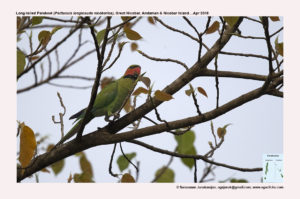
| Long-tailed Parakeet Psittacula longicauda
Etymology:
Vernacular Names: Nicobar: Talaka, Talahi |
Distribution in India: Resident of Andaman & Nicobar in India.
Description: Size of 40–48 cm; wt. of 168–196 g. The upper mandible is red, lower is blackish red; the crown and area above line from cere to eye is dark green; area from lower mandible and chin tapering onto lower sides of neck is black. Rest of head and nape are rose pink, shading to pale yellowish green on mantle and upper back, pale bluish on lower back, green on uppertail-coverts. The undersides are greenish yellow shading slightly darker on belly. The wings are green with dull blue on primary coverts and primaries. The tail is deep blue centrally, outer feathers are green. The female replaces rose pink on head with dull orange-red, with blue wash on ear-coverts; bill is all brownish. The immature is mainly green, some orange-red tinge on sides of head. The races defontainei has deeper red on head, yellowish crown; race modesta crown appears brownish, as feathers dull red mixed with green, duller brownish in female; race tytleri has crown, nape, mantle and upper back as yellowish green, rump and lower back are green; race nicobarica has bright green crown with yellowish green nape. Race nicobarica is the largest.
Habitat: It is found in coastal regions, mangroves, swamp forest ,rain forest edge, partly cleared land, oil-palm plantations, coconut groves.
Food Habits:It eats outer covering of betel nuts, papaya, ripe fruit, flowers and seeds. It is seen as a pest in oil-palms, plucking ripe fruits to eat the soft mesocarp.
Breeding Habits: They Breed in Dec–May in Malaysia; Jun in Kalimantan; Oct in Sumatra; Feb–Apr in Andaman and Nicobar islands. They nest in a hole in tree. They lay a clutch of 2–3 eggs. Incubation period is 24 days.